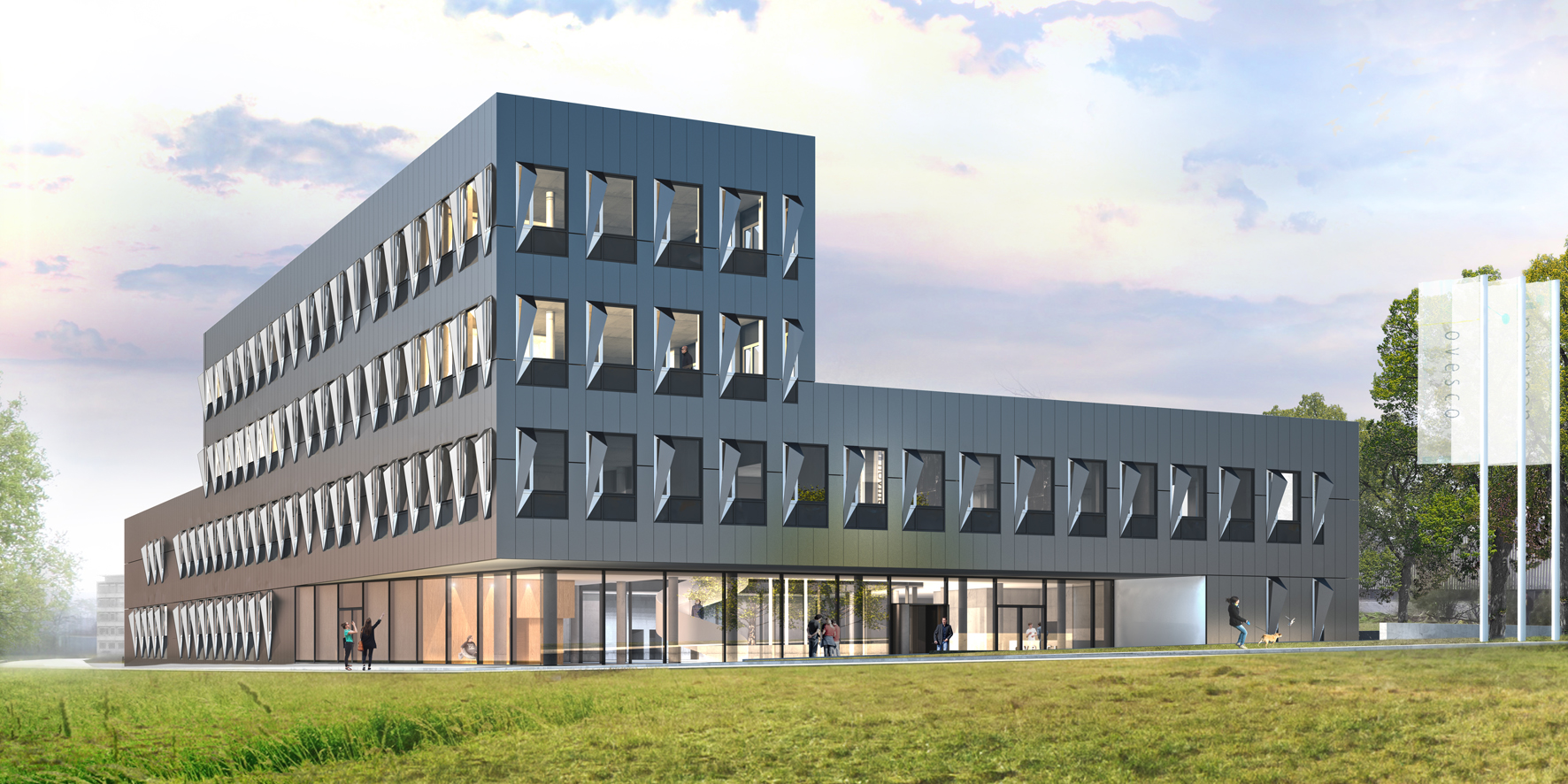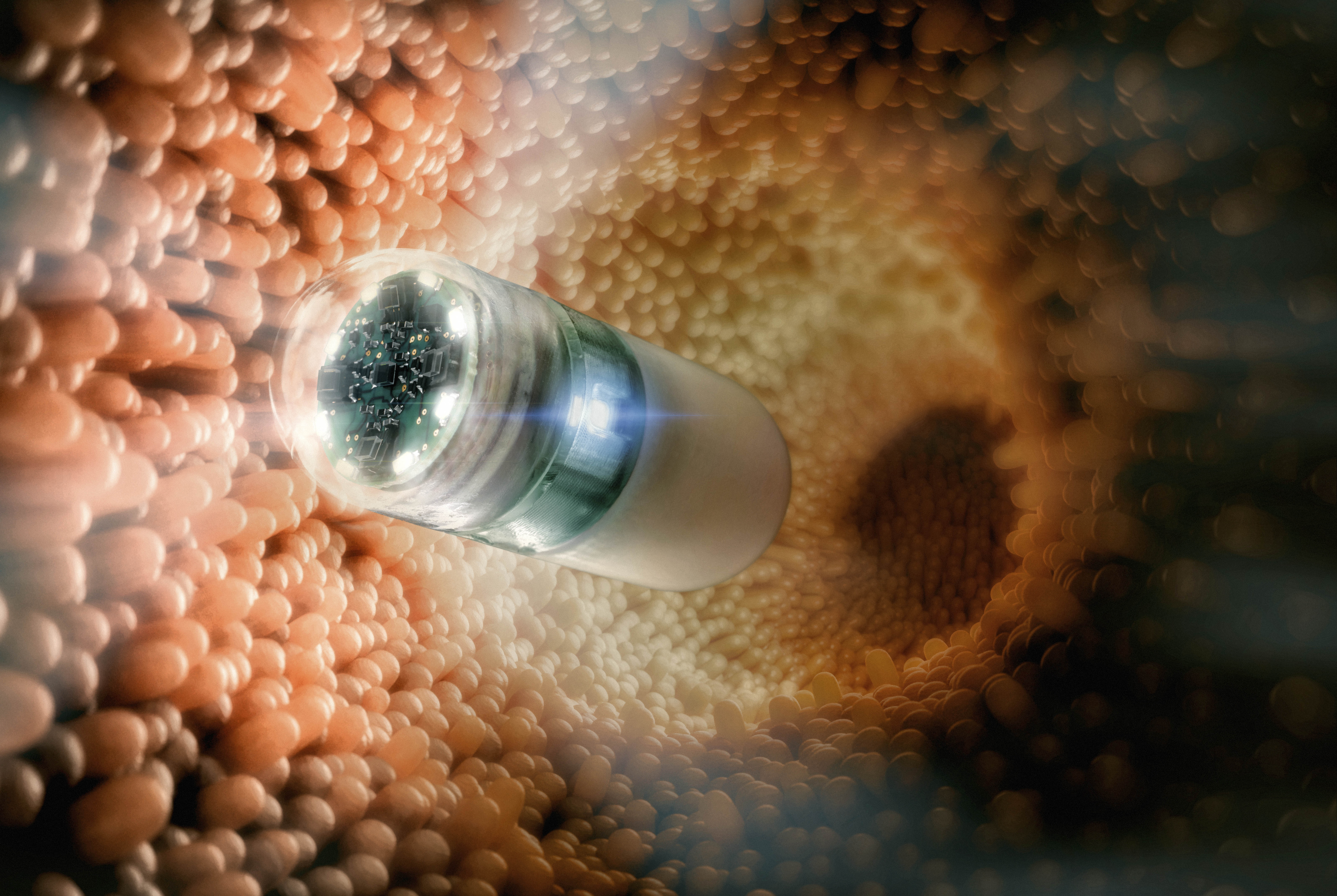Innovations in the field of endoscopy
Gastroscopies with pill cameras
A pill camera to examine the gastrointestinal tract that can be swallowed without major difficulty, controlled intuitively from the outside and deliver images in real time - why would any doctor or patient say no? To non-experts, it sounds more like science fiction but such a device is actually already in development: since 2019, Tübingen-based Ovesco Endoscopy AG and three partners have been working together on this in a project called nuEndo.
Nobody likes having a gastroscopy. The procedure has long been a standard medical procedure worldwide and many clinics and doctor’s practices perform the procedure with flexible endoscopes after anaesthetising the throat or while the patient is sedated. However, most patients find the examination very uncomfortable. The procedure is also not entirely without risk. The psychological stress of a potential gastric disease has to be high before patients are willing to submit themselves to gastroscopy. The procedure can only be carried out by specifically trained specialists, so long waiting times are not uncommon.
The nuEndo research project is seeking to change this situation. With almost 1.7 million euros of funding from the German Ministry of Education and Research (BMBF) up to 2022, the Tübingen-based company Ovesco Endoscopy AG, an expert in technologies for endoscopic and surgical therapy in the gastrointestinal tract, is working on the development of a diagnostic gastroscopy procedure involving capsules. In addition to Ovesco, which is coordinating the project, robotics specialist SENSODRIVE GmbH - a spin-off from the German Aerospace Center. V. (DLR) - in Weßling, Bavaria, the Fraunhofer Institute for Reliability and Microintegration IZM in Berlin and the Robert Bosch Hospital in Stuttgart are also involved in the project.
Completely new wireless variant for diagnostic purposes
 Ovesco Endoscopy AG in Tübingen specialises in technologies for the endoscopic and surgical therapy of the gastrointestinal tract and is coordinating the nuEndo project. © Ovesco Endoscopy AG
Ovesco Endoscopy AG in Tübingen specialises in technologies for the endoscopic and surgical therapy of the gastrointestinal tract and is coordinating the nuEndo project. © Ovesco Endoscopy AG"Ovesco was founded by a group of doctors and scientists, and we have been working on the development of wireless endoscopy for a long time as part of a precursor project for nuEndo," says Dr. sc. hum. Dipl.-Ing. (FH) Sebastian Schostek, development manager for diagnostic systems at Ovesco and project coordinator of nuEndo. "Wireless endoscopy is already a very competitive market and many companies and research institutions are working on it. But so far, the lack of technological framework has prevented products from reaching a marketable level."
Capsule endoscopy is a procedure that has been used since 2000 to record internal images of the gastrointestinal tract. A capsule equipped with a camera, battery and radio transmitter travels in the same way as food through the gastrointestinal tract, which has been cleaned by laxatives, and takes pictures at regular intervals. "This is a great thing in itself, very patient-friendly and especially suitable for the small intestine, which is difficult to get into with conventional endoscopes," explains Schostek. "But what we are now doing is completely different. Our nuEndo capsule will be controllable, which means rather than it "tumbling" through the intestines like food, the doctor is able to go back and forth and look around in the intestines. It will also deliver pictures in real time. This enables us to intervene with immediate therapy using a tube endoscope if necessary. One thing is clear: while tube endoscopes will not be replaced by a wireless version for therapeutic interventions, capsules can be used for diagnostic purposes just like normal endoscopes with flexible tubes. This is a safe procedure and much gentler on the patient, reducing the instinctive aversion for endoscopies and increasing the chance of treating a disease before it has progressed too far."
 The Endotrace project - a precursor to nuEndo - developed a capsule camera for examining the small intestine in detail. © Volker Mai Fraunhofer IZM
The Endotrace project - a precursor to nuEndo - developed a capsule camera for examining the small intestine in detail. © Volker Mai Fraunhofer IZM"The nuEndo capsule is relatively large - about as long as the first phalange of our little finger - but it can be swallowed very well," said Schosteck. In addition, the whole procedure will be much faster. Swallowing food - and in this case the capsule - is a natural process. This does away with what can be a relatively complicated insertion of the tube and also prevents damage. "Until now, the procedure has required specially trained doctors and a lot of practice," says Schostek. "In contrast, examinations with the nuEndo capsule do not require doctors to be present all the time, they can come once preparations are complete. When there is a shortage of doctors, this can help reduce the pressure on the healthcare system. This is one of several goals we are pursuing."
Pill camera is magnetically guided in a gentle way
The two biggest technological challenges associated with the development of the nuEndo capsule are the limited storage capacity of the battery, as the procedure requires sufficient energy for at least 20 minutes to guarantee illumination, image acquisition and data processing and transmission. Another challenge is the speed of data transmission to ensure that the images are delivered smoothly in real time. "We need a technology that is able to transmit videos within milliseconds," says Schosteck. "Putting all of this into such a small capsule is a challenge. This led to many failures, but now we have technological approaches available to do this.”
The novel capsule integrates electronics, a camera and a magnet into a plastic envelope wrapped around the batteries to create as much space as possible for the energy sources. The capsule is around eleven millimetres in diameter, has a very smooth surface to make it easy to swallow, and basically looks exactly like a conventional endoscope capsule. Thanks to the integrated magnet, the pill camera can be guided through the gastrointestinal tract in a controlled way using a cooperating guide arm. It is used only once. "Since the batteries contain no heavy metals, flushing the pill camera away through the sewage system is unproblematic," says Schosteck.
Prior to the examination, patients have to drink a large amount of water to enlarge their stomachs. The capsule is then swallowed and is already transmitting images in the oesophagus. With a gentle but constant magnetic force, the examining doctor can direct the capsule into the stomach. "Nothing gets stuck and you don't feel anything, the examination is much gentler than with an endoscope," says the Tübingen expert.
Great innovation for doctors and patients
The project partners are currently working on a functional model consisting of a capsule and a guide arm. "The interaction of the two components is complex. A lot of sensor technology is involved, for example to coordinate information about the position of the capsule with the control movements," says Schostek. "Controlling the pill camera should be very intuitive and no more difficult than controlling a toy car. This is a prerequisite for market acceptance."
By the end of the project in 2022, the partners want to have developed a fully functional demonstrator for the system, which is also designed as medical device. In addition, the scientists would like to further develop the pill camera so that it can be used not only for gastroscopy, but also for examinations of the entire gastrointestinal tract. “There is a lot still to be done,” says the researcher. "But if everything goes to plan, the nuEndo capsule could be on the market in a few years. It would be a really big innovation for everyone involved."